
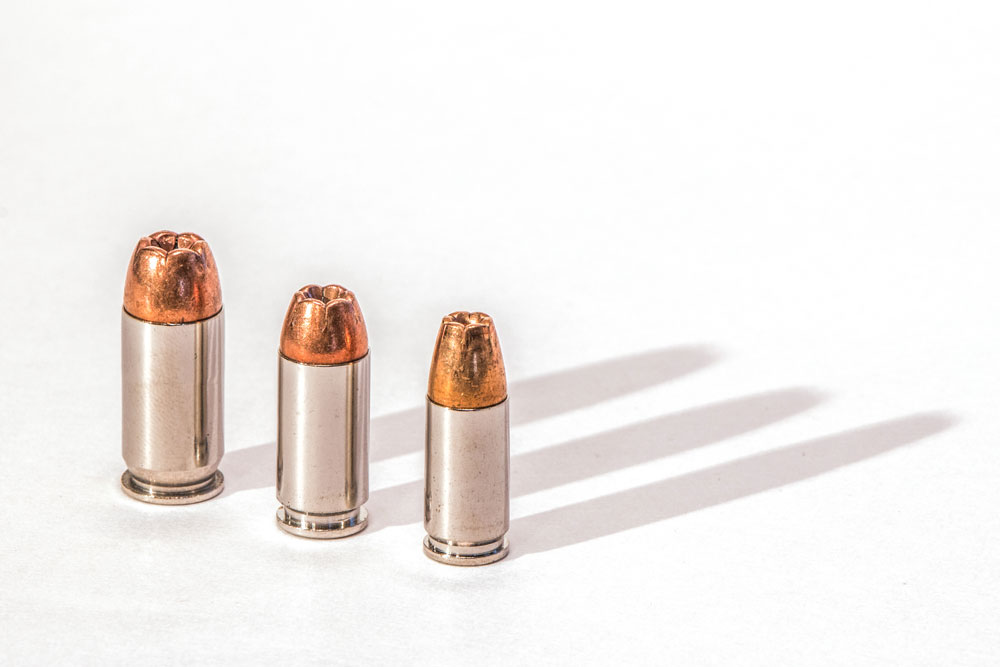 Of all of the firearms related quarrels, none rival the argument over which auto pistol cartridge is best for personal defense. This is partly because personal protection is very important, partly because folks assume there has to be a single best answer, and finally because there exists no definitive proof that one works any better than another.
Of all of the firearms related quarrels, none rival the argument over which auto pistol cartridge is best for personal defense. This is partly because personal protection is very important, partly because folks assume there has to be a single best answer, and finally because there exists no definitive proof that one works any better than another.
With auto-pistol cartridges a triangle analogy is appropriate because you’re trying to balance a three-sided equation. On one side of the triangle we have power, on another speed, and finally, capacity. This triangle exists because a human hand can only control so much force, because a bullet’s speed is what makes it work, and because if capacity didn’t matter we’d all be carrying derringers.
Arm Yourself With More Concealed Carry Knowledge
With the 9mm Luger, .40 S&W, and .45 Auto, you have three approaches to solving the problem. Each of these cartridges has its strengths and weaknesses. So, to better understand the solution, we need to look at how each cartridge interfaces with each side of the triangle.
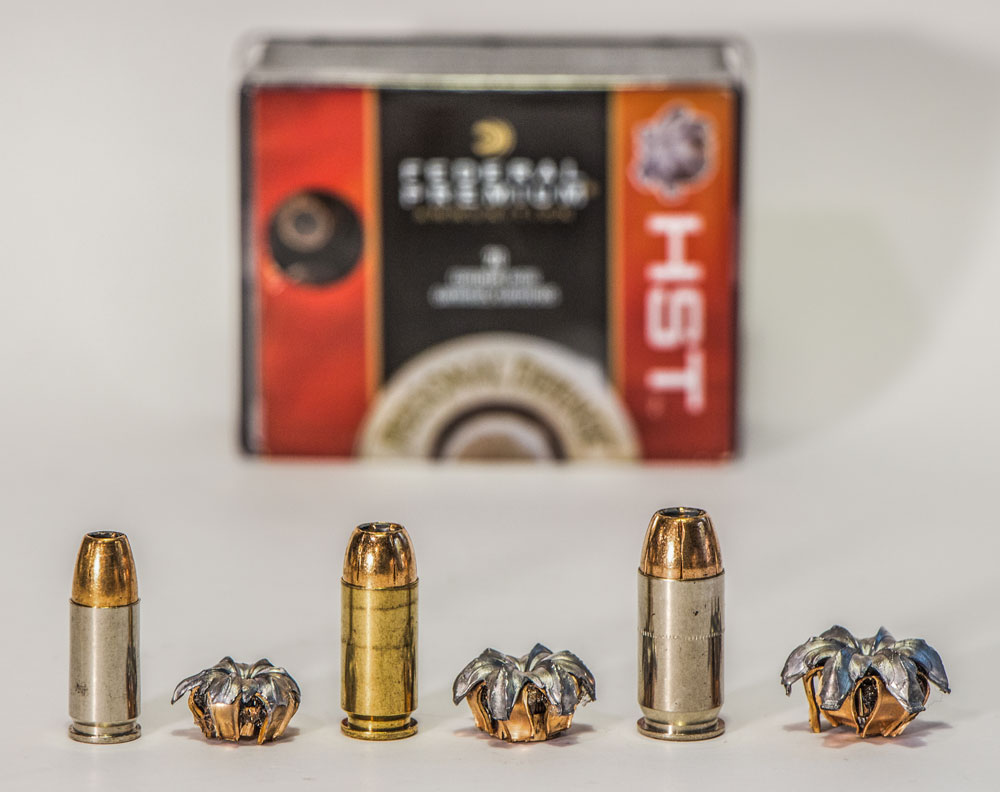
Power
Historically we’ve measured defensive handgun cartridge power by kinetic energy. It is nothing more than velocity squared, times bullet weight. Momentum is another, though a less referenced, measure of power and it is mass times velocity. Additionally, there exist various formulas for calculating the mythical assumption known as “stopping power.” Some of these formulas are thought to divine, by number, a cartridge’s ability to stop bad guys. Those numbers are simply conjecture.
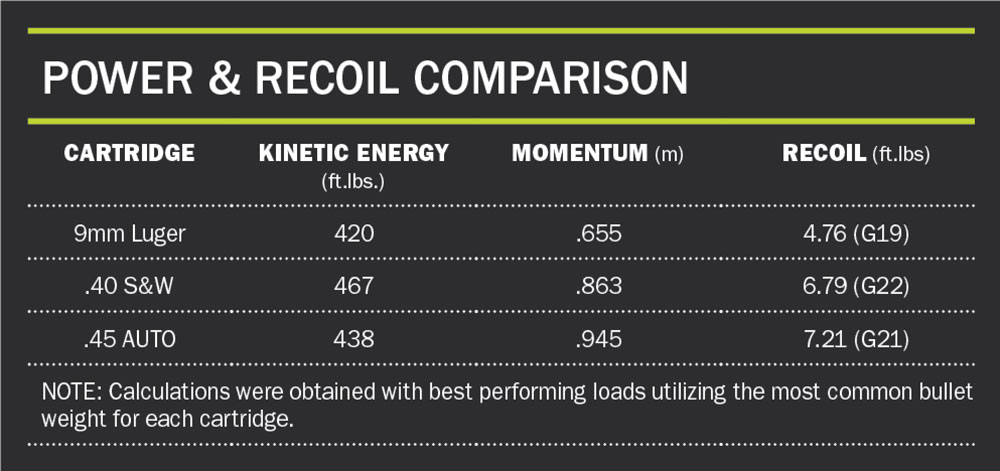 If we compare the commonly considered best 9mm, .40, and .45 loads using kinetic energy and momentum, we discover some interesting facts. There’s very little difference in the kinetic energy figures, but from the momentum standpoint the .45 Auto has a clear edge. But, power matters on both ends (if recoil were not an issue we’d all be carrying a .44 Magnum). Comparing the recoil of these cartridges in fully loaded Glock 19, 22, and 21 pistols, we see the other side of the power argument. The 9mm Luger generates 66 percent of a .45 Auto’s recoil, but delivers 96 percent of its kinetic energy and 69 percent of its momentum.
If we compare the commonly considered best 9mm, .40, and .45 loads using kinetic energy and momentum, we discover some interesting facts. There’s very little difference in the kinetic energy figures, but from the momentum standpoint the .45 Auto has a clear edge. But, power matters on both ends (if recoil were not an issue we’d all be carrying a .44 Magnum). Comparing the recoil of these cartridges in fully loaded Glock 19, 22, and 21 pistols, we see the other side of the power argument. The 9mm Luger generates 66 percent of a .45 Auto’s recoil, but delivers 96 percent of its kinetic energy and 69 percent of its momentum.

Speed
Some argue velocity doesn’t matter when it comes to defensive handgun cartridges. This of course is beyond absurd. The .38 Special and .357 Magnum shoot the same bullet, but due to the higher velocity of the .357, there’s no question it’s a better neutralizer. The faster a bullet is pushed, the more rotational velocity it has. This helps engineers develop more terminally effective projectiles that damage more tissue.
 What few understand is how all this translates to stopping a threat. Bullets make bad guys bleed. The more they bleed and the more the wound hurts, the sooner they’ll stop their bad behavior. Formulas cannot predict this. Comparing the terminal performance of five of the best 9mm, .40 S&W, and .45 Auto loads, the differences are minimal. The 9mm has a slight edge in penetration, the .45 a slight edge in expansion, and the .40 S&W is sort of a compromise.
What few understand is how all this translates to stopping a threat. Bullets make bad guys bleed. The more they bleed and the more the wound hurts, the sooner they’ll stop their bad behavior. Formulas cannot predict this. Comparing the terminal performance of five of the best 9mm, .40 S&W, and .45 Auto loads, the differences are minimal. The 9mm has a slight edge in penetration, the .45 a slight edge in expansion, and the .40 S&W is sort of a compromise.
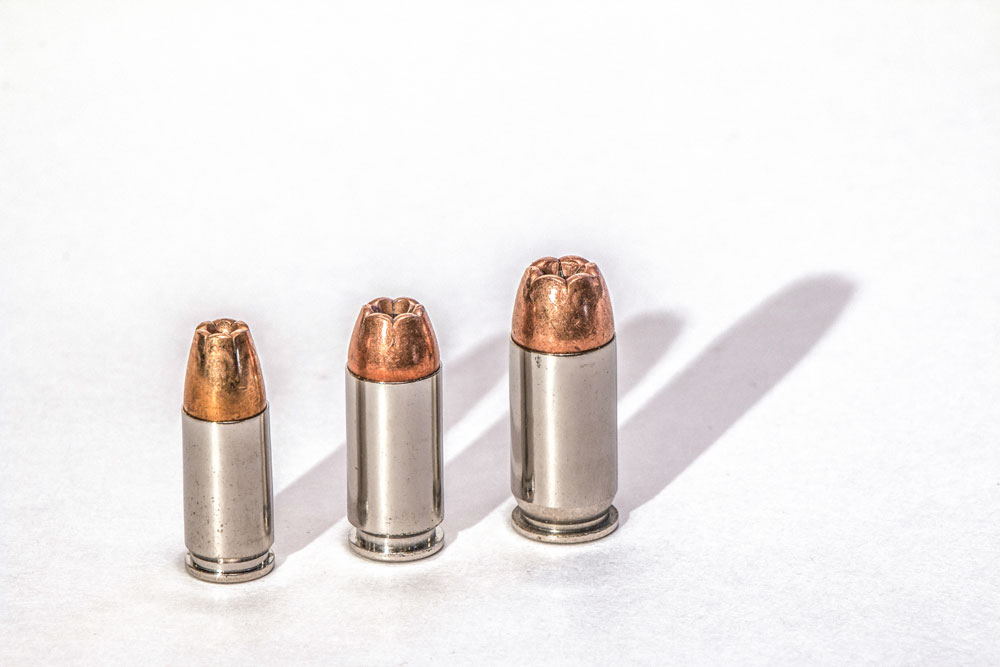
Capacity
Capacity comparison is simple. Regardless of the size of the handgun, it will hold more 9mm cartridges than .40 S&W, and more .40 S&W cartridges than .45 Auto. Putting an exact number on this is impossible. However, by again comparing similar sized Glocks, we see the 9mm (Glock 17) holds 17 rounds, the .40 S&W (Glock 22) holds 15 rounds, and the .45 Auto (Glock 21) holds 13 rounds.
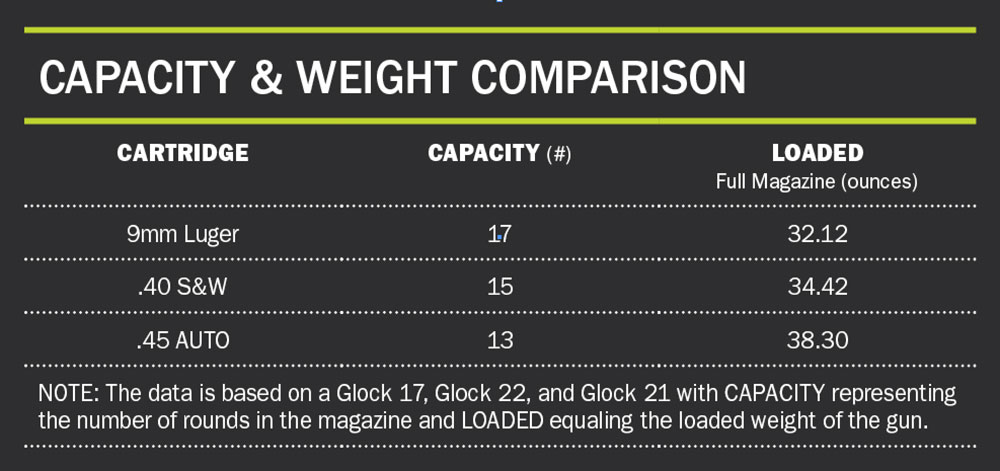 The 9mm has a weight advantage also. Even though 9mm pistols hold more ammo, the lighter 9mm cartridges keep loaded gun weight below that of comparable and loaded .40 and .45 pistols. This means they are easier to carry all day and, even though they weigh less, they still produce lighter recoil.
The 9mm has a weight advantage also. Even though 9mm pistols hold more ammo, the lighter 9mm cartridges keep loaded gun weight below that of comparable and loaded .40 and .45 pistols. This means they are easier to carry all day and, even though they weigh less, they still produce lighter recoil.
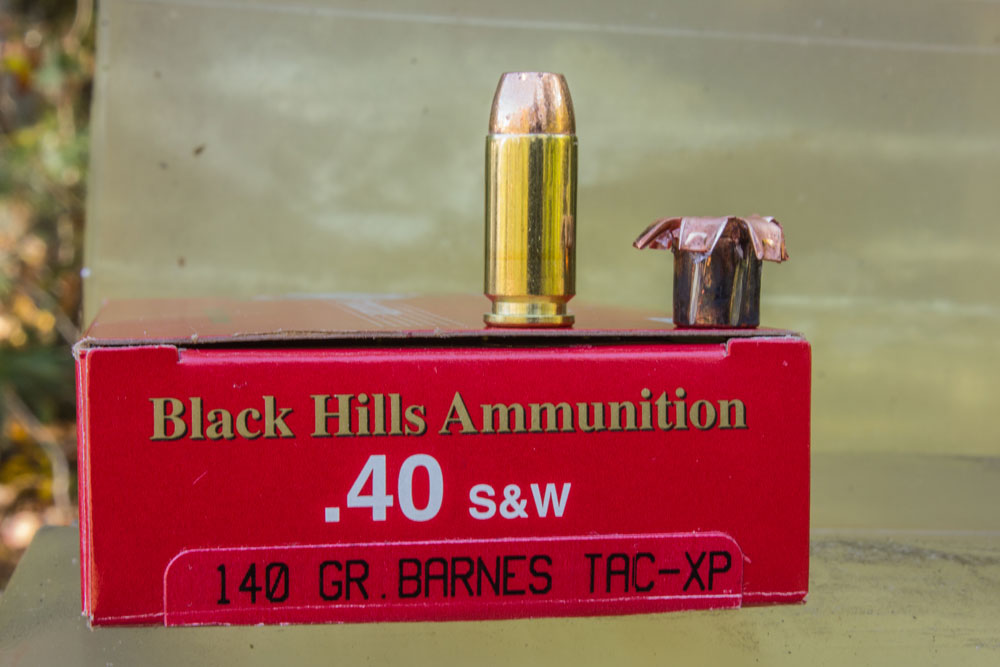
The Compromise
The argument has always been big bullets versus small bullets and low velocity versus high. It's all a trade off—you cannot have both high velocity and a big bullet because you’re right back to the .44 Magnum. The .40 S&W was built as a compromise cartridge to offer more power than the 9mm, with less recoil and more capacity than the .45. Since 1990 it has been the darling of law enforcement. But that’s changing.
It appears the FBI, the organization responsible for the .40 S&W due to its dissatisfaction with the 9mm, has now concluded that the 9mm solves the triangle better. This is largely because it’s easier to shoot faster and more accurately, by more agents. Since agents are people, too, the conclusion applies to regular folk just the same. The FBI also acknowledges modern bullet technology has all but eliminated the terminal performance differences between these cartridges. In short, smart guys who make bullets figured out how to utilize the ballistic differences of each cartridge to practically equalize their terminal effectiveness.
The FBI has realized the shooting part is more important the anything else. Misses or bad hits don’t stop fights. The focus has wisely shifted from ballistics to marksmanship! What a novel concept.

The Real Difference
There are measureable differences between these cartridges. But surgeons will tell you, you cannot look at or into a cadaver and definitively tell which cartridge was responsible for the damage that put it on the coroner’s slab. The differences that matter most are on the shooting end. Does the pistol fit your hand? Can you control the recoil and get accurate hits, fast? Does the gun hold enough ammunition for you to effectively solve a problem? And, can you conceal it and manage to carry it all day? Shooters must find a handgun/cartridge combination delivering the best balance of power, speed and capacity, given the size of the handgun they want to carry, and their ability to manage that handgun. You’re better off spending your time trying to balance the interface between the shooter and the pistol than between the cartridge and the bad guy. All three cartridges are plenty good, but in the end, you gotta be able to shoot.
Editor's Note: This article is an excerpt from the Concealed Carry 2016 issue of Gun Digest the Magazine.
Raise Your Concealed Carry IQ:

Next Step: Get your FREE Printable Target Pack
Enhance your shooting precision with our 62 MOA Targets, perfect for rifles and handguns. Crafted in collaboration with Storm Tactical for accuracy and versatility.
Subscribe to the Gun Digest email newsletter and get your downloadable target pack sent straight to your inbox. Stay updated with the latest firearms info in the industry.

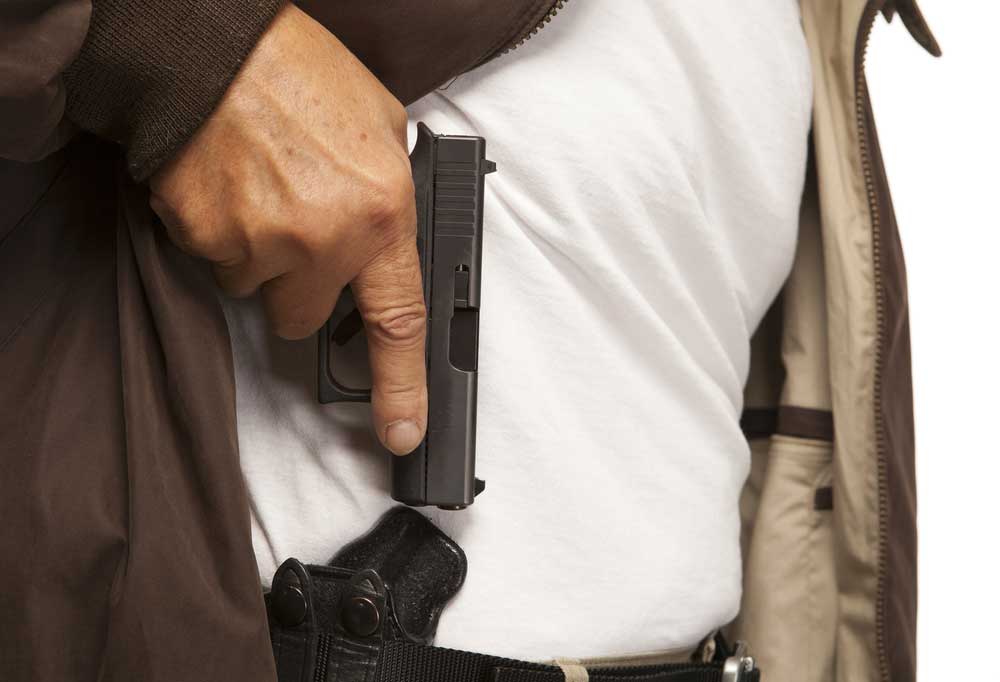
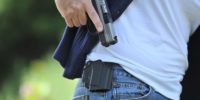

![Best Concealed Carry Guns In 2025 [Field Tested] Wilson Combat EDC X9S 1](https://gundigest.com/wp-content/uploads/Wilson-Combat-EDC-X9S-1-324x160.jpg)


![Best 9mm Carbine: Affordable PCCs [Tested] Ruger Carbine Shooting](https://gundigest.com/wp-content/uploads/Ruger-Carbine-Shooting-100x70.jpg)
![Best AR-15: Top Options Available Today [Field Tested] Harrington and Richardson PSA XM177E2 feature](https://gundigest.com/wp-content/uploads/Harrington-and-Richardson-PSA-XM177E2-feature-100x70.jpg)

I love many guns and one woman. I carry a 10mm because it has high capacity and very good ballistics. Recoil not really an issue having been somewhat enamored with big caliber handguns for a long time. I can shoot it very fast and put rounds on target very fast. I like it a lot.
The FBI dropped the .40 S&W to allow their newer crop of female agents and other delicately framed personnel handle it. The reasons were more shooter than ballistics related. Hire more girls and you need a more ‘girl friendly’ weapon.
I don’t know how they perform on human body tissue and really don’t want to ever find out. I make sure I can shoot any firearm I put in my hands safely and accurately. I’d imagine any cartridge could be deadly, and at the least, damaging. I will avoid at all costs, having to find out by paying attention to my environment. Other than that , I have fun and love shooting all kinds of firearms well enough. I pity anyone that endangers me by attempting to end my life. Although it’s unlikely I would encounter such a situation as I will always avoid such a situation.
I’m not surprised that people who own a particular caliber of brand/model of handgun think there choice is best. The only “experts” I put any credence are military physicians who’s job it is to evaluate small arms and their ballistic effectiveness. I was a law enforcement coroner and saw with my own eyes what works best. I will try to relate to the reader my observations, which are backed up by the knowledge medical professionals. These people are the only ones you should listen to for up to date information.
#1 the handgun, regardless of caliber, is a poor performer when contrasted with a shotgun or rifle calibers and/or loads. #2 the larger wound channels and deeper penetration of larger pistol caliber perform best. There are variables such as under penetration of certain expanding loads that fail to “stop” aggressive actions of armed criminals/enemy soldiers because they fail to penetrate into the vitals.
Handguns are a compromise. All pistol calibers can terminate a suspect intent of harming yourself or others. But, like the FBI shootout in Florida, inadequate rounds allow the suspect to kill agents before they bleed out. I do not believe the 9 x 19mm is the best caliber regardless of the opinions of the FBI or arm chair experts. It is a compromise. If you miss a lot than having a high capacity magazine will prove beneficial.
Always pick a rifle or shotgun as your primary self defense weapon, when heading into a hostile situation. If you must compromise than picking a proven large caliber load as your handgun of choice giving best results.
I refuse to endorse a caliber or make of handgun because of the reason enumerated above. Compromise is not the best criteria for choosing your secondary weapons system. What you choose as a handgun is dependent on your skill, ability to handle recoil, and the current loads for your caliber and choice of handgun.
This article clearly doctors the speed and energy figures. What improvements have been applied to the 9mm have also been applied to ALL other cartridges.
The 40 SW is quite capable of producing 600 flbs of energy which the 9 mm +P+ cannot come close to, nor can the standard 45.
Please look at a couple of reloading manuals, I am not inventing anything. Hornady lists a 155 grains XTP at 1300 fps which produces 582 lbs or energy……
The author and a few of those who posted are clearly 9mm fanboys. There is nothing wrong with that. Where there is something wrong is doctoring speeds and energy figures to stack one’s favorite deck.
Lastly the remark about the gentleman regarding the capacity of the Glock 19 falsely portrayed in the initial article as a “standard” 19 rounds capacity handgun expose the writer’s newness, inability to verify what he writes or edit himself if you will and his ignorance on the subject.
Every couple of months, someone new wants to enter the arena of the gun writers. There are many legitimate ones but many who haven’t done their homework and want to project an imperial level, shall we say, of savvy. In fact they are less knowledgeable than most people who post. It’s fine to decree yourself a writer overnight but refrain from misinforming readers only to boost your shaky (not to say false) claims. Do your homework first and then become a writer. There is an apprenticeship in every domain. You haven’t completed yours.
Great article. We call go to the range and shoot and shoot and shoot until we think we are experts. We bring home targets with ragged holes shot out of the center and proudly hang them up. But how accurate will we be when a bad guy is actually pointing a gun back at us? I’ll take capacity and accuracy over bullet size any day.
What Federal HST rounds have 420 foot pounds at the muzzle? Their 124, 147, and 150 grain rounds are 364, 326, and 270 foot pounds respectively. Hornady’s DUTY and DUTY +P are only 306 and 369 respectively. Moreover, Federal’s 230 grain .45 ACP HST rounds are only 404 foot pounds of energy (and not 438).
The thing that really matters is what any particular individual is comfortable with, and can shoot well. While a fatter, heavier bullet is likely to do more damage (and maximum damage is what is intended), it must be put in the proper place, and within a rather short period of time. It’s better to hit your adversary between the eyes with a .22LR, than miss with a .50AE. Shoot the biggest thing you can shoot well.
My brother-in-law is an Orthopedic Surgeon here in Sao Paulo, Brazil. He moonlights (yes, doctors in the US make much more money!) as a Coroner.
The public can never legally carry anything larger than a .380, and the police are limited to 9mm. Choices for sidearm? Yea… one! Only the Taurus manufactured in Brazil. Only the criminals have the good stuff. Glock, Sig, HK, etc., are confiscated on a daily basis and then probably re-sold back to the criminal by the arresting officer!
Beto, my brother-in-law, has stated that from what he sees that shows up on his table, he would never carry a .40 or a 9mm… only the .45.
Me? I am a good shot, great in emergencies, and much more confident in carrying a 9mm simply because of the follow up shots. I am much more accurate with a .45, but that is target practice. My times and scores for stress situations are much better with a 9mm, single stack, small as possible weapon.
In the final analysis, I think you should carry the largest bullet, heaviest gun possible, and still not drop your ability to fire at moving targets, hit them, and empty your magazine before being hit.
Ok you made the comment “surgeons can’t tell by looking at a cadaver on a slab which caliber put them there.”
Two problems with that.
1 If it’s on a slab in a morgue it would be a pathologist or coroner looking at it. Any experienced of those could definitely tell the difference by the size of the entry/exit holes and surrounding tissue damage. That’s their job.
2. Having worked on many a poor soul in a trauma OR for almost 25 years, where surgeons do see the damage, I can say with a personal record of about 72% accuracy that just looking at x-rays I know whether it’s a 9mm or a 45acp. That goes up drastically once I see the actual wound. Even the high end expanding 9mm self defense round make small dime to nickel sized holes, unless they hit long bone, the bone is shattered and small pieces of the bullet are mixed in with the bone fragments. . The 40 makes nickel to quater sized holes long bones are also shattered and big pieces of bullet are present. The 45acp rounds make lemon sized holes, long bones are powdered and the mostly intact bullet is found past the bone not in its fragments.
When it comes to vitals hit, heart, lungs, liver. Heart hits well all calibers the victim is gone by the time they reach us. Lung, 9mm unless it’s in the hylum no problem ewsy fix sew up the hole, 40 you’re missing a small chunk of lung to fix same with the hylum, 45acp well that lobe of the lung is a goner. Hylum hits 9mm if the Pulmonary artery and vein are not directly hit pain in the arse but fixable, 40 same, 45acp d.o.a. even a near miss shreds the P.A. and P.V. Now on to the liver. 9mm makes messy holes that are fillable with coagulants, 40 larger holes that require the use of lots of electrocautery as well as the coagulants, 45acp usually we have to resect that section of the liver to stop the bleeding due to that area is pretty much liquified.
This has been my actual experience working in US Navy during Desert Storm and a level one trauma facility in Washington DC for more than 2 decades. We have a VERY active gun and knife club and the police, secret service and miltary police shoot lots of people with a combination of these rounds, the bad guys add even more. You see as many holes as I have you can easily tell the difference
I live in the UK so this is really not applicable in my paranoid country. That said, I have lived and worked in countries and types of employment where I’ve had to use a personal sidearm to defend myself. A 9mm Hi power as it happens. That pistol will always be my first choice for the very good reason that I know it inside out and I can shoot it fast and accurately. Which is the point. Discussions of which cartridge is “best” are ultimately pointless. The “best” cartridge and handgun combination is the one you can shoot well enough under all conditions to hit your target repeatably and thereby make carrying it worthwhile. I would much rather have someone miss me with a 45 than hit me between the eyes with a 22!
Massad Ayoob said it best:
“There are people who say 9mm is okay and .45 is okay. Other people say 9mm is feeble, and .45 is okay. What nobody is saying is that .45 is not okay.”
He went on to add that, when he was in charge of caliber policy, in the department in the northeasten state where he lived, their winters would cause the nose-cavities of hollow-point bullets, in the cold months, to be clogged by passing through winter-clothing layers, meaning that expansion would be very poor, i.e., his officers would for all practical purposes be shooting ball: “… and if my officers were going to be shooting ball, I ____-well wanted it to be .45 ball.”
You can make a case for each of the 3 (plus .357Sig) being the best. Actually the statistical result show little difference between them. Part of this lack of differences can be attributed to good, modern bullet design. Mostly it is due to the fact that there is no magic bullet or caliber.
Another propaganda article to try and save the dying .40 S&W cartridge.
Fact: The 40 S&W is the worst of both worlds. It has neither the massive frontal area of the .45 acp nor the easy recoil and high capacity of the 9×19.
Fact. Many if not most of the guns chambered for the 40 S&W were originally designed for 9mm size handguns. This has resulted in premature failure of the frames and even internal parts of those guns re-chambered for the heavier kicking 40 S&W. This has been very true in the plasticky framed guns.
Fact. The best bullet for the 40 S&W is the 180 grain but the Ammo companies have deliberately down loaded this weight bullet because of reported blow ups in brand new guns firing factory ammo in this bullet weight. The problem came from bullet set back. The .40 S&W has little air space to zero air space with the original hot loading for the 180 grain bullet resulting in detonation if the cartridge suffers bullet set back during the feeding cycle. Combat Handgun Magazine reported blow ups with a Glock, a Browning High Power and a Ruger, all known for their durability. Since then because of the scale back in the amount of powder being used in the 180 grain loadings everyone has switched to the less powerful 160 grain loadings.
The .40 kicks harder which makes it more difficult to shoot by Police who often do not shoot their guns except once a year in qualification. The ammo is more expensive than 9×19 ammo and the wear and tear on many guns that are chambered for this hated cartridge wear out much sooner than for the 9×19 or .45 acp. Many Police departments have dropped it in favor of the 9×19 and the civilian market hates the cartridge with a passion. Its sales have dropped off dramatically in recent years resulting in gun writers prostituting themselves all over the gun rags trying to save the doomed .40 S&W from oblivion.
Fact. The .45 ACP is and always has been a dud round. In 1945 the U.S. Military tested the .45 acp against the 9×19 and found to their horror it was a completely dud cartridge. It bounced off of a military helmet at a scant 35 yards while the 9×19 penetrated it at an astonishing 125 yards both guns using military fmj ammo.
Fact. The .45 acp knock down stories are a propaganda myth dreamed up by prostitute gun writers following the U.S. war of aggression against the Pilipino people in 1899 to 1912. Jan Libourel now retired gun writer found no records in the U.S. Military archives that stated the .45 acp did such things and as a matter of fact he found just the opposite as no hand gun the U.S. used including the .45 long Colt and the .45 acp was any better than the .38 colt cartridge also used in that conflict.
Fact. Pistolero Magazine in the 1980’s shot barn yard pigs with the .45 acp and the 9×19 and found no difference in killing power at all. They found the pigs jumped higher and squealed louder when hit by the 9×19 and it killed them just as well.
Fact. In my own testing on large Whitetail Deer the 9×19 was superior to the .45 acp as the slow moving, low penetration of the .45 acp resulted in its really running out of steam the longer the range was as compared to the superior penetration of the 9×19 cartridge. The 9×19 killed deer with no problems.
Fact. The 9×19 with its cheaper cost, lower recoil, higher capacity and longer service life to pistols is the superior police cartridge and that goes double with todays modern expanding ammo.
As a civilian you can use any mythical cartridge you may want but pistols are very anemic weapons to use when trying to stop a determined attacker. Only a head shot (which often results in the bullet glancing off the curved surface of the head) or a spinal shot (pure luck) will stop a determined attacker no matter what pistol caliber you are using or what ammo you are using. Its interesting to note that old time hunters like Samuel Baker who probably killed more deer and hogs with the aid of a pack of hounds found the best killer instrument at close range was a special long knife he had custom made for this purpose rather than using a pistol. True back then and true today. Just maybe the Romans and their Galdius sword knew more than we know today.
As an addendum: As far back as the year 1900 it was found that caliber had no effect on killing power what-so-ever and that is was bullet penetration and placement that killed. Many old time African Ivory Hunters ended up getting themselves killed precisely because they used very large calibers that often had insufficient penetration as compared to smaller rifle calibers that penetrated much better and were used by poor African Farmers to wipe out wild game threatening their crops. They used surplus cheap and often worn out military rifles in calibers such as the 7×57 and 8×57 and the .303 British not the super expensive big game double rifles because both the guns and ammo were way beyond their financial ability to purchase.
In conclusion I quote perhaps one of the greatest and most unknown gun writer and hunter that ever lived,
Agnes Herbert and yes she was a woman who taught people to shoot with both eyes open rather than follow the advice of the contemporary gun writers who advocated the opposite. She, when first becoming familiar with hunting and firearms and being of superior intellect soon came to the conclusion that the gun writers of that era did not know what the hell they were talking about. My how little things have changed in 117 years.
I guess those guys in WWII using the Thompson in 45 acp didn’t cause much damage…or the mobsters with their Tommy guns…lol. Here, watch this and tell how much of a dud the 45 acp is.
https://www.youtube.com/watch?v=GQtmbW4uGMY&index=1&list=PLuHmsXlc1Lcclods-TbfTgn0N_YnivfiB
And for your further entertainment, here is one on 9mm vs 40. It is what it is.
https://www.youtube.com/watch?v=LTTDgZZZFa0
I beg to differ. The best caliber is 357 Sig. I load a 115 gr. Nosler HP that runs approx. 1350 fps out of my M&P 40c with a Storm Lake 3.5″ Sig barrel. The felt recoil, to me, is less than my 135 gr. .40 at approx. 1300 fps. I,also, find the 357 Sig to be more accurate.
Bad guys, I mean really bad guys, have discovered body armour. Your modern, fancy expanding bullets won’t do anything but give them a bad bruise. I’ll stick with my basic Yugo Tokarev shooting a 90 grain truncated cone FMJ at 1390 fps that will blow right through standard body armour, thank you very much.
Mr. Mann and Gun Digest Editors: this is a sloppy inaccurate article with poor editing. Was this published to the “Concealed Carry 2016 issue of Gun Digest the Magazine” AND here on the Internet by an intern with little knowledge of guns?
Quoting the article: “Comparing the recoil of these cartridges in fully loaded Glock 19, 22, and 21 pistols, we see the other side of the power argument.”
The Glock 19, 22, and 21 are not the “similar” guns for what I believe you are trying to communicate in this article which is projectile performance/recoil impulse of the different cartridges from barrels of the same length. The similar combination would be Glock 17, 22, and 21 with the 17 and 22 having a 4.48″ barrel and the 21 having a 4.6″ barrel. The G19 has a 4.01″ barrel.
Later in the article we get to the word “similar” and you clearly don’t get the guns correct which casts doubt over all of the data in the article. If Gun Digest can’t get its Glocks identified correctly how can any of the remainder of the article have any validity? Not knowing the Glock product line for a gun magazine editor is like a pilot not knowing what an airplane is. Was all of the Glock 19 data measured with a Glock 19 or was it a Glock 17 and you just made a whole slew of typos by calling the G17 a G19?
“However, by again comparing the similar sized Glocks, we see the 9mm holds 19 rounds, the .40 S&W holds 15 rounds, and the .45 Auto holds 13 rounds.”
The Glock 19 standard capacity is 15 rounds. The Glock 17 standard capacity is 17 rounds. Neither the G19 or the G17 hold 19 rounds unless you have purchased an extended magazine or extended base plate. Someone seems to believe that the “19” in Glock 19 means 19 rounds of standard factory magazine capacity.
Let this reader help you with your Glocks grouped by barrel length since barrel length will be a determining factor in kinetic energy, momentum, and recoil.
G19 – 9 mm, 4.01″ barrel, 15 round standard capacity
G23 – .40 S&W, 4.01″ barrel, 13 round standard capacity
G17 – 9 mm, 4.48″ barrel, 17 round standard capacity
G22 – .40 S&W, 4.48″ barrel, 15 round standard capacity
G21 – .45 ACP, 4.6″ barrel, 13 round standard capacity
If you have a picture of that Glock 19 with a 19 round standard capacity factory magazine then you would have a big news scoop. How did you get the weight of a G19 with 19 rounds? Pictures or it didn’t happen.
This is real sloppy work at a minimum. The whole article needs to be revisited to correct the errors or simply be pulled from the web site. C’Mon MAN!
First off, thanks for reading and thank you for taking the time to comment and offer feedback on the article. You’re absolutely right. There were errors made within this piece concerning the different Glock model numbers and their respective magazine capacities and weights. These were honest mistakes, but mistakes that nonetheless should have been caught within the editing process.
These errors have now been addressed, as should be reflected in the text and in the charts within the article.
Below are some comments from the author of the story, Richard Mann:
“I used the G19 in the first reference because it represented a similar difference in size, with regard to the weight and barrel length differences between the G22 and G21.
I intended to reference the G17 in the capacity section but erroneously listed the 19. I then listed the 19 and its loaded weight again by accident in the capacity chart.
I must have had 19 on the brain because I listed it instead of the 17 and with a capacity of 19!
However, the point of the article still remains: You’re better off spending your time trying to balance the interface between the shooter and the pistol than between the cartridge and the bad guy. All three cartridges are plenty good, but, you gotta be able to shoot.”
Thanks again for your comments. We take errors very seriously, and we encourage you and all of our readers to reach out any time errors are thought to be present.
Sincerely,
Drew Warden
Managing Editor, Gun Digest the Magazine
Thanks for the update. I believe I knew what the article was trying to communicate however I was more stunned by the glaring errors which Mr. Mann’s comments on his though process explain.
Even with these changes the article has some continuity errors which still communicate the point Mr. Mann is trying to make if the reader is already informed on this topic but is still confusing.
Why do we do the energy calculations on a Glock 19 and weight and capacity calculations on a Glock 17 while leaving the G22 and G21 as constants? We talk about apples by grouping G19+G22+G21 to discuss energy then we talk about oranges when grouping G17+G22+G21 to discuss weight.
The purpose of using a G19 in the energy comparison is never stated. The purpose of using a G17 in the weight comparison is never stated. We’re just using a G19 here and a G17 there but we don’t touch the G21 or G22 and we do this without explanation.
Read this paragraph: “If we compare the commonly considered best 9mm, .40, and .45 loads using kinetic energy and momentum, we discover some interesting facts. There’s very little difference in the kinetic energy figures, but from the momentum standpoint the .45 Auto has a clear edge. But, power matters on both ends (if recoil were not an issue we’d all be carrying a .44 Magnum). Comparing the recoil of these cartridges in fully loaded Glock 19, 22, and 21 pistols, we see the other side of the power argument. The 9mm Luger generates 66 percent of a .45 Auto’s recoil, but delivers 96 percent of its kinetic energy and 69 percent of its momentum.”
The reader must have Mr. Mann’s comments in order to understand the paragraph was trying to illustrate a 9 mm round from a barrel that is 0.59″ shorter than the .45 ACP G21 barrel yet still has 96% of the .45’s kinetic energy while only having 66% of recoil and 69% of momentum.
Then we jump to this paragraph: “The 9mm has a weight advantage also. Even though 9mm pistols hold more ammo, the lighter 9mm cartridges keep loaded gun weight below that of comparable and loaded .40 and .45 pistols. This means they are easier to carry all day and, even though they weigh less, they still produce lighter recoil.”
Except we’re no longer talking about the G19 we’re talking about the G17. It appears to me that the purpose of the using the G17 is to show that 17 rounds of 9 mm in a Glock is lighter than 15 rounds in a G22 and 13 rounds in a G21….more bullets weighs less….
I suspect the G17 was selected for the weight discussion because the G19 only has 15 rounds and you wouldn’t be able to say “more bullets weighs less” because the G22 also has 15 rounds which would be “same number of bullets weighs less.”
If the 9 mm G19 with 4.01″ barrel has 96% of the .45 ACP G21 with a 4.6″ barrel then simple math likely says that the 9 mm G17 with 4.48″ barrel should be something greater than 96%…say 97.5% or more….
I don’t think this article is well planned for the topic Mr. Mann is trying to communicate. If I didn’t already have some level of savvy on this topic who knows how confused I would be.
I would recommend going back to a storyboard and reorganize and rewrite the article.
why do people behind their computers get so mean and nasty. pointing out errors does not mean someone has or should belittle someone else. this argument will continue through infinity.
now i am an old fart and my memory is not what it use to be. back in the day before these great new bullets. there were statistics on one shot stops. funny thing it was the 357 that was king of the hill. i believe it would be today also. speed kills not size. the 556 is a better round because of speed. the 357 was better because of speed. i believe the ammo makers are dropping the speed in a lot of calibers even the 357. sure you can find some that are still loaded appropriately but a lot are not, even in a lot of the expensive defensive rounds. now back then before the great bullets what came close to the 357 was the 40 with 155 grain bullet. why? back to speed again. i would not buy 180 grain for my 40. i have since quit carrying my 40 although, i trust it more then most, because i carry a 357 sig. which gives you almost the speed of the 357 mag. yes i do give up some rounds but the nice thing about a glock is you can carry bigger mags for reload.
so why has the world turned to 9 mm. because it is shootable by more people and departments have to go with what works most of the time for most people. it is not cost because the government just charges us they don’t give a F@@@. everyone says close and that is true but i would rather have a couple of percentage points in my favor then not. if you cannot handle the recoil go with something you can, that is logical, right?? if your department says everyone has to shoot the same caliber, well i guess you go with a 9 mm. i started with the forty because it was faster and bigger. the 45 is slow and that is why everyone started carrying the flying ash tray in it to gain more speed. speed kills!!
the Strasbourg test shoot goats eating in the same location and time the deaths was eye opening. of course now goats are more important then human lives so we cannot do it anymore. this was before the new bullets. the 9 was not as good as the 40. the 357 sig gave me what i wanted which was close to 357 mag velocity with a lot more ammo. funny in that test some of the calibers that were tested, after the goat was shoot it just kept eating. now for someone to claim a knife is a better weapon well first it takes a whole lot more training. we are back to velocity, the shock factor of a bullet. i certainly would not want to wait for some bad guy to bleed out on me while still trying to hurt me. as they say don’t bring a knife to a gun fight. certainly a good knife person at 20 feet or less can come and kill you before he dies, but i will take my chances with a gun and as many rounds as i can put on target. there is no one stop knife statistics. SPEED KILLS AND THEN SIZE ALSO MATTERS!! DUMPING AS MUCH ENERGY IN THE TARGET AS YOU CAN UNTIL THE TREAT STOPS. as stated it is mass times velocity squared, the speed means more then the mas. momentum is just the heavier bullet wants to keep moving more. if you can penetrate enough momentum is not much of a variable. accuracy is key and if you cannot get good placement, well, it does not matter. if you shoot a 9 better then a 40 go with the nine it is close but it is not equal and never will be if you load for speed. speed kills…